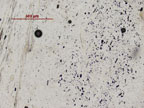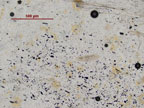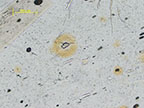|
Cordierite
|
|
Property
|
Value
|
Comments
|
| Formula |
Mg2Al3[AlSi5]O18 |
Fe2+ can substitute for Mg in octahedral sites, although most cordierite is fairly Mg rich. Fe3+ may substitute for Al. |
| Crystal System |
Orthorhombic |
(pseudohexagonal) |
| Crystal Habit |
Anhedral to to highly irregular porphyroblastic grains, less common as hexagonal prismatic crystals. Lamellar and cyclic twins common. |
Often uncludes numerous inclusions of quartz, opaque grains, and other minerals. Twinning more common in high-grade metamorphic rocks. |
| Cleavage |
Fair cleavage on {010} and poor cleavage on {100} and {001}
|
Not usually obvious in hand sample or thin section. Subconchoidal fracture. Brittle. |
| Color/Pleochroism |
Gray, grayish blue, blue, or indigo blue.
X = colorless, pale yellow, pale green; Y = pale blue to violet; Z= pale blue
|
In thin section: Colorless to very pale blue; darker with increasing Fe content. Usually no pleochrosim, though grain mounts may be distinclty pleochroic. |
| Twinning |
Lamellar and cyclic twins are common, but not visible in hand sample. The twin planes are {110} and {130}. |
Twins in longitudinal section may resemble twins seen in plagioclase but thin sections may be stained to distinguish cordierite from the feldspars. Twins are more likely in cordierite from high grade metamorphic rocks than in medium-grade rocks. |
| Optic Sign |
Biaxial (+ or -) |
Rarely biaxial (+). |
| 2V |
35-106° |
Mostly biaxial (-) with 2V between 40 and 90°. High water and Na content yield lower 2V angles.
|
| Optic Orientation |
X = c, Y = a, Z = b |
Elongate crystals are length fast. |
Refractive Indices
|
alpha = 1.527-1.560
beta = 1.532-1.574
gamma = 1.537-1.578
delta = 0.005-0.017
|
Indices of refraction increase with Fe content and also with H2O content in channels. |
| Max Birefringence |
0.005-0.017 |
Low birefringence yields first-order white/gray/yellow interference colors. |
| Extinction |
Parallel |
|
| Dispersion |
r < v |
Weak. |
| Distinguishing Features |
Resembles quartz, bur more distinctly blue. Corundum is harder. Twinned cordierite resembles plagiclase in thin section, but plagioclase has more distinct cleavage and lacks radial twinning. Yellowish, pleochroic halos around radioactive minerals such as zircon are quite common. Typically contains small, opaque inclusions. Hardness = 7. |
| Alteration |
Cordierite is readily altered to pinite, a fine-grained greenish or yellowish aggregate of chlorite, muscovite and other silicates. The alteration may develop along cracks and grain margins. |
| Occurrence |
Cordierite is a common mineral in medium and high-grade pelitic metamorphic rocks. It is also common as porphyroblasts in hornfels found in contact metamorphic zones. Favored by low pressures or high temperatures. It is rare in igneous rocks, and may result form the assimilation of aluminous sediments.
Associated with chlorite, andalusite, sillimanite, kyanite, staurolite, muscovite, biotite, and chloritoid. Granite, pegmatite, gabrros, and andesite infrequently contain cordierite.
|
| References |
Nesse, William D., 2000. Introduction to Mineralogy. Oxford University Press, New York, 442 p. |
| Editors |
Christina Gooch ('07), Chiza Mwinde ('18) |


